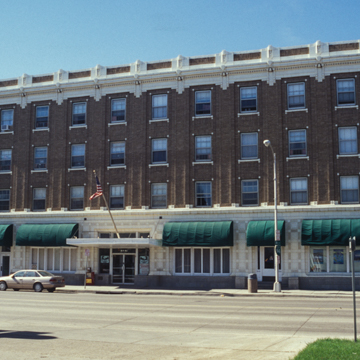You are here
Commercial and Residential Building (Lewis and Clark Hotel)
Governor Louis Benjamin Hanna, a businessman from the Red River Valley with interests in lumber, grain, and banking, demolished the Inter Ocean Hotel and replaced it with his Lewis and Clark Hotel. The former hotel is constructed of pressed brick, with white ornamental trim and an elaborate polychrome terra-cotta cornice. At its opening, newspaper accounts touted it as the “Pride of Mandan” and proclaimed it “one of the most beautiful hotels in the Northwest.” The hotel’s architect, Gage, was born in New York City and studied architecture at the University of Illinois. He began his career in 1911 with the firm of Long, Lamoreaux and Long of Minneapolis, and from 1912 to 1913 was with Ellerbe and Round of St. Paul. After moving to Fargo in 1913, Gage drafted for Haxby and Gillespie until 1915, when he and Archie Ashelman began their firm here. Around 1919, Gage moved to Seattle and eventually to California in 1921. In partnership with Harry Koerner, Gage designed the Beverly Hills City Hall.
In 1930, a fire consumed the rear of the Lewis and Clark Hotel. Fargo architect Kurke coordinated the repair and expansion of that part of the building to three stories to include ten apartments, ten additional hotel rooms, and business offices occupying the ground floor. The former Billiards Room was recently converted to a community church.
Writing Credits
If SAH Archipedia has been useful to you, please consider supporting it.
SAH Archipedia tells the story of the United States through its buildings, landscapes, and cities. This freely available resource empowers the public with authoritative knowledge that deepens their understanding and appreciation of the built environment. But the Society of Architectural Historians, which created SAH Archipedia with University of Virginia Press, needs your support to maintain the high-caliber research, writing, photography, cartography, editing, design, and programming that make SAH Archipedia a trusted online resource available to all who value the history of place, heritage tourism, and learning.















